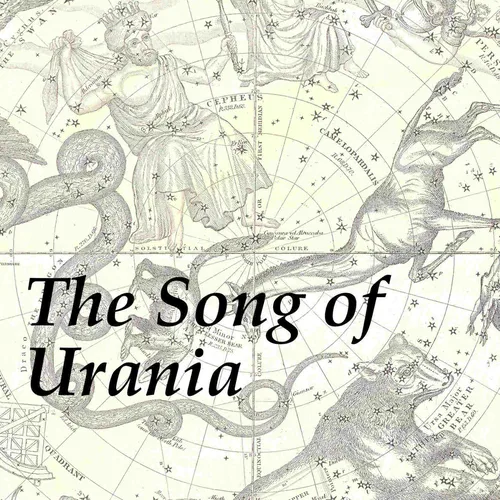
The Song of Urania
A history of astronomy, from antiquity to the present.
- Update frequency
- every 29 days
- Average duration
- 48 minutes
- Episodes
- 47
- Years Active
- 2021 - 2024

Episode 47: Clock Around the Rock
We turn to the astronomy of Mesoamerica, with a particular focus on the Maya and Aztec. The central feature of their astronomy was a pair of interlocking calendars which regulated all aspects of life…

Episode 46: The Stars from Starboard
The most important application of astronomy in Polynesian societies was oceanic navigation. Polynesian navigators regularly traversed from one small island to another across hundreds of miles of open…

Episode 45: Looking Up Down Under
Aboriginal Australian societies are believed to be among the oldest continuous cultures on the planet. Some of their oral traditions appear to preserve a cultural memory of celestial events from mult…

Episode 44: Ad Maiorem Dei Gloriam Per Astra
In his second attempt, Matteo Ricci was able to gain access to the Forbidden City. Over the next century, the Jesuits came to surprising influence in China through their knowledge of European astrono…

Episode 43: When the Saint Comes Marching In
After the fall of the Mongol Yuan Dynasty, the Ming Dynasty drove the few small Nestorian Christian communities in China underground and largely closed China off to foreigners. Only in the 16th cent…

Episode 42: A Tale of Two Reforms
After Wang Mang had usurped the Imperial throne, a disastrous series of reforms led to the collapse of his dynasty. The reestablishment of the Han Dynasty called for yet another calendar reform. Abou…

Episode 41: Liu Xin's Theory of Everything
After Wang Mang deposed the Han Dynasty and instituted his new Xin Dynasty, he needed to promulgate a new calendar to mark the occasion. One of his court astronomers, Liu Xin, developed a new calenda…

Episode 40: Emperor Wu's Woo
We learn about the political events and omens that led to the calendar reform of 104 BC.

Episode 39: The Guest Stars
We turn to the ways that the Chinese Emperor's astronomers predicted and interpreted eclipses, as well as the so-called "guest stars" that they occasionally reported observing in the skies. Then we d…

Episode 38: The Organization of Heaven & Earth
This month we turn to the astronomy of China in the early Imperial Era. We look at the way that the Emperor's astronomers were organized within the imperial bureaucracy and then walk through the thre…

Episode 37: The Mandate of Heaven
We start to explore the relationship between the heavens and the Earth in Ancient China, along with the role of astronomers. One of the most important concepts in Chinese political thought to emerge …

Episode 36: Aryabhata & the Siddhantas
In our final episode on ancient Indian astronomy, we tour the five astronomical Siddhantas, and then meet some of the astronomers whose names and works survive to us, most importantly, the great Arya…

Episode 35: The Vedanga Jyotisha & Beyond
We delve into the contents of the Vedanga Jyotisha, the earliest Indian text to deal explicitly with astronomy. Then we turn to early Hindu cosmology and their explanations for various celestial phen…

Episode 34: What Happened in Harappa
India developed one of the most advanced astronomies of any of the ancient cultures, even rivaling European astronomy in its accuracy by the 18th century. We look at how the geography of India influe…

Episode 33: How the Moon Became Blue
We take a break from the main narrative in honor of this month's blue moon and turn to a somewhat more frivolous topic — how the term "blue moon" came to mean the second full moon in a calendar month…

Episode 32: All Along the Watchers of the Hour
This month we tour the astronomers of ancient Egypt from the Old Kingdom to the last native Pharaoh of Egypt just prior to Alexander's conquest. We look at how astronomers fulfilled their primary res…

Episode 31: We Need to Talk About Khufu
Before getting back into Egyptian astronomy proper, we start by looking at Nabta Playa, a site of megalithic activity in the Nubian desert during the late neolithic. Then we turn to the megaliths the…

Episode 30: Egypt in a Nut-Shell
We turn to ancient Egypt, one of the oldest and most beguiling of the ancient civilizations. Egypt is particularly notable for the sheer conservatism of its civilization and changed little in more th…

Episode 29: The Astronomy of Saharan and Sub-Saharan Africa
The oldest plausible astronomical artifacts known are African, as are many of the oldest megaliths, around 10,000 of which dot the Sahara and whose orientations are astronomical in character. We then…

Episode 28: The Stars in Stone
We turn the clock back to the astronomy of the Paleolithic and Neolithic. Clues about humanity's interest in the heavens during the Paleolithic can be seen in linguistic, mythological, and archaeolo…